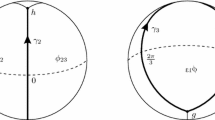Abstract
We give a necessary modification of Proposition 1.18 in Nagy and Strambach (Loops in Group Theory and Lie Theory. de Gruyter Expositions in Mathematics Berlin, New York, 2002) and close the gap in the classification of differentiable Bol loops given in Figula (Manuscrp Math 121:367–385, 2006). Moreover, using the factorization of Lie groups we determine the simple differentiable proper Bol loops L having the direct product G 1 × G 2 of two groups with simple Lie algebras as the group topologically generated by their left translations such that the stabilizer of the identity element of L is the direct product H 1 × H 2 with H i < G i . Also if G 1 = G 2 = G is a simple permutation group containing a sharply transitive subgroup A, then an analogous construction yields a simple proper Bol loop. If A is cyclic and G is finite and primitive, then all such loops are classified.
Similar content being viewed by others
References
Conway J.H., Curtis R.T., Norton S.P., Parker R.A., Wilson R.A.: Atlas of Finite Groups. Clarendon Press, Oxford (1985)
Figula Á.: 3-dimensional Bol loops as sections in non-solvable Lie groups. Forum Math. 17(3), 431–460 (2005)
Figula Á.: Bol loops as sections in semi-simple Lie groups of small dimension. Manuscr. Math. 121, 367–384 (2006)
Hilgert J., Hofmann K.H.: Old and new on \({SL_2(\mathbb R)}\) . Manuscr. Math. 54, 17–52 (1985)
Hu S.-T.: Homotopy Theory. Academic Press, New York (1959)
Huppert B.: Endliche Gruppen I. Springer, Berlin (1967)
Jones G.A.: Cyclic regular subgroups of primitive permutation groups. J. Group Theory 5, 403–407 (2002)
Koszul J.L.: Variante d’un théoréme de H. Ozeki. Osaka J. Math. 15, 547–551 (1978)
Loos O.: Symmetric Spaces, vol. I. Benjamin, New York (1969)
Miheev P.O., Sabinin L.V.: Quasigroups and differential geometry. In: Chein, O., Pflugfelder, H.O., Smith, J.D.H. (eds) Quasigroups and Loops: Theory and Applications. Sigma Series in Pure Math. 8, pp. 357–430. Heldermann-Verlag, Berlin (1990)
Nagy G.P.: A class of simple proper Bol loops. Manuscr. Math. 127, 81–88 (2002)
Nagy, P.T., Strambach, K.: Loops in Group Theory and Lie Theory. de Gruyter Expositions in Mathematics, 35. Berlin, New York (2002)
Nazaryan R.O.: Minimal factorization of simple real Lie groups (Russian). Izv. Akad. Nauk Arm. SSR 10(5), 455–477 (1975)
Onishchik, A.L.: Decompositions of reductive Lie groups (Russian). Mat. Sb., Nov. Ser. 80(4), 553–599. English transl.: Math. USSR, Sb. 9, 515–554 (1969)
Ozeki H.: On a transitive transformation group of a compact group manifold. Osaka J. Math. 14, 519–531 (1977)
Tits, J.: Tabellen zu den einfachen Lie Gruppen und ihren Darstellungen. Lecture Notes in Mathematics, 40. Springer, Berlin (1967)
Author information
Authors and Affiliations
Corresponding author
Rights and permissions
About this article
Cite this article
Figula, Á., Strambach, K. Subloop incompatible Bol loops. manuscripta math. 130, 183–199 (2009). https://doi.org/10.1007/s00229-009-0279-y
Received:
Revised:
Published:
Issue Date:
DOI: https://doi.org/10.1007/s00229-009-0279-y



